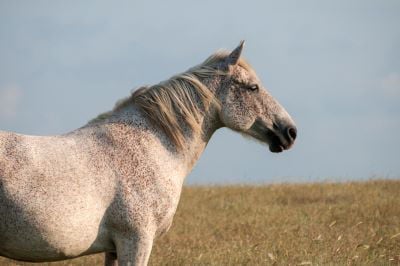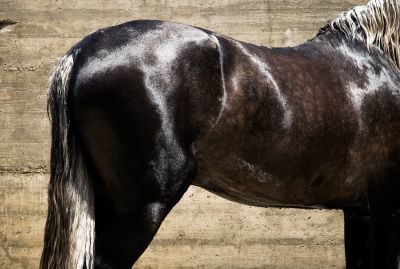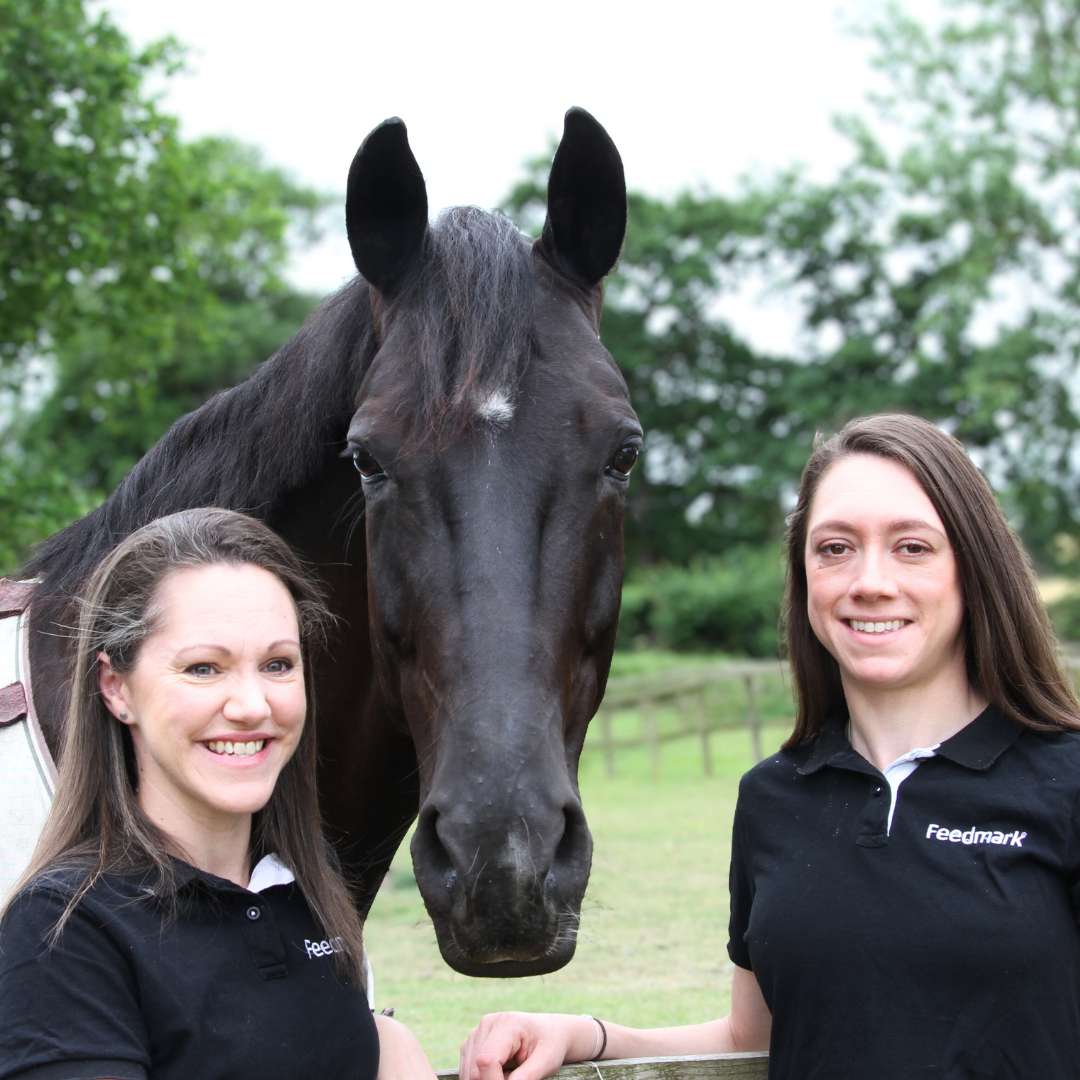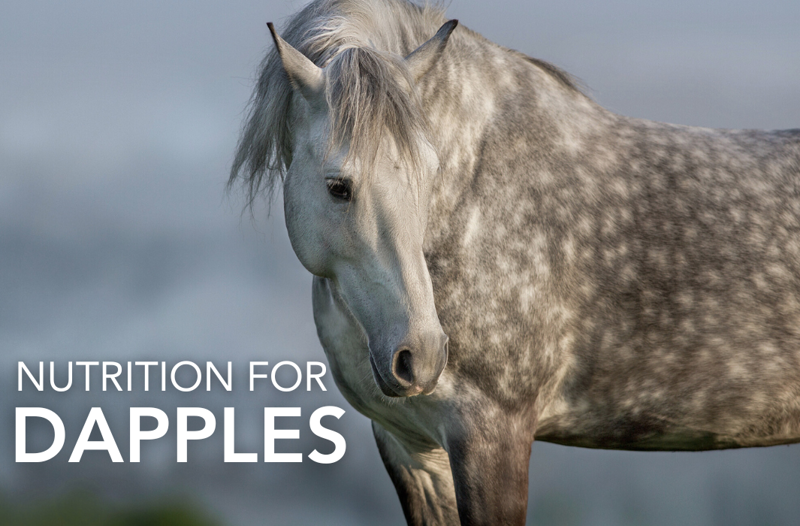Written by Sophie Pelham Burn (MMedSci ANutr.)
What are dapples?
Dapples are the eye-catching, and often admired, circular patterns that can appear on a horse’s coat. They are most commonly seen on grey horses but can also occur in other colours too. They are traditionally thought to be a sign of good health, but other factors also influence their appearance.
What causes dapples on horses?
The colours a horse’s coat can produce are defined by genes, which determine the expression of pigments within each hair shaft. As these pigments are contained within the hair shaft itself, rather than the skin, dapples often appear or disappear with the seasons and the changes from summer to winter coat or clipping.
The two main pigments are
- Eumelanin; responsible for black and brown colours
- Phaeomelanin; responsible for red and yellow colours
Variations in how much of these pigments, and their combinations within each hair shaft, determine the colour.
Fun Fact: Chestnuts who are homozygous for the recessive e allele on the MC1R locus are genetically unable to produce the eumelanin pigment, so cann't produce strongly pigmented dapples regardless of any other factor.
Why grey horses lose their dapples with age
In grey or white horses, a further genetic variation blocks production of these pigments. Grey is a progressive coat colour. Foals will often be born with a hyperpigmented coat and gradually lose their colour over time, due to the gene STX17. This gene causes the pigment producing cells to gradually stop producing as much of the pigment, so that each time the hairs grow back they become lighter and lighter.
Dappling or flea-bitten patterns are the result of some pigment producing cells slowing down faster than others and are referred to as transition patterns as the horse becomes progressively whiter with age. Horses with two copies of the STX17 gene (one from each parent) will lose their colour and dapples at a younger age than those heterozygous alleles.

Flea-bitten patterns are the result of some pigment producing cells slowing down faster than others.
The silver dapple gene
Silver dapple is a variation in other coat colours that occurs due to a specific gene that alters distribution of the eumelanin (black) pigment but doesn’t change the expression of the phaeomelanin (red) pigment. Several different breeds carry this gene, and it is passed down the breeding line in an autosomal dominant manner, meaning that only one parent needs to pass the gene down to their offspring for them to display this characteristic.

Andalusian horse with the silver dapple gene
Different coat colour variations
All other variations of coat colours and patterns are a result of a lack of pigmentation, genetic dilutions, or different patterns of gene expression. The dapples come from fluctuations in the intensity and distributions of the pigments along the hair shaft as it’s growing, and as nutrition can affect expression of certain genes, nutrient availability plays a role in production of the dapple pattern.
Nutrition for Dapples
Horses who have a genetic ability to produce dapples may not always show them in the coat. Nutrition and stable management practices have a huge impact on horses’ overall health and wellbeing, which is often reflected in the horses’ appearance. If one or more nutrient requirements aren’t being met due to an unbalanced diet, illness or other type of physical or psychological stress (that can increase requirements for some nutrients), these will be diverted away from the maintenance of a healthy-looking coat to fuel other functions which are more necessary for survival. As such, a horse’s coat will only look its best when all other aspects of health are optimal.
Micronutrients - Minerals
Horses on a forage only or restricted grass ration are often deficient in several micronutrients, with the most likely being Copper, Zinc, Cobalt, Iodine, Manganese and Selenium.
As well as ensuring your horse has adequate amounts of these minerals, the ratios in relation to each other are also important. Zinc and Copper are both absorbed into the blood stream from the gut using the same transportation pathway, which is also responsible for absorption of Iron. An excess of one of these minerals would saturate the Divalent Metal Transporter 1 (DMT1), resulting in a deficiency of the other minerals, even though their quantity in the feed itself may be adequate. A typical diet forage-based diet provides a relatively high intake of iron, so it is important that intakes of copper and zinc are balanced to allow optimal absorption of all three minerals. In addition, the form in which these minerals are included in feed or balancers also influences absorption, with their chelated form demonstrated to be most readily absorbed.
Copper deficiency is characterised by hair that breaks or damages easily, as this mineral is required to form cross-linkages in the proteins that give hair its correct structure. It is also involved in production of melanin, a pigment which is required for colouration of the hair shaft and skin.
Zinc is required in the enzymatic functions required to synthesise keratin, which is another vital component of healthy hair.
Micronutrients – Vitamins
Whilst some vitamins are particularly important for the skin and coat, all vitamins are necessary for overall health. If a horse is replete in the vitamins and minerals required for hair production but deficient in others, it is still likely to be reflected in the overall condition of the horse. However, some notable vitamins are:
Vitamin A – Requirements are based on a horse’s age, workload, life-stage (growth or reproduction) and physical condition. It plays a key role in the function of the immune system, eye health, mucous membranes and connective tissue including skin. It is obtained from fresh grass and hay in the form of beta-carotene, which is then converted to retinol, the active form of vitamin A. During winter months when access to fresh pasture is limited carrots can provide a good source of beta-carotene, as well as being a tasty treat. Deficiency can lead to dull, flaky and dry skin and hair.
Vitamin B Complex – B Vitamins are a group of water-soluble vitamins, responsible for a variety of functions including metabolism and the conversion of macronutrients into energy. They play a crucial role in supporting the nervous system, immune function, digestive health and supporting skin, hair and hoof turnover and production. Whilst B vitamins can be made in the hindgut by the microbiota, factors such as age, stress, or issues relating to digestion including parasitic infections, diarrhoea and dental problems can impact their production. Biotin is one of the B vitamin family that is particularly beneficial for hoof and hair health due to its role in keratin formation.
Vitamin E – This vitamin is also predominantly obtained from pasture. It helps protect against cell damage from free-radicals, and as such plays a key role in healthy skin and coat. As it is an antioxidant molecule, its levels decline the longer it is stored, so supplementation may be warranted in winter when horses are being fed hay as a substitute for fresh grass. Those in hard work are also likely to require supplementation.
Micronutrients – Omega 3
Fats and oils in the horses’ diet help keep skin supple and moisturises the hair shaft, especially in conjunction with regular grooming to help move the naturally produced oils through the horses’ coat. Keeping the coat well hydrated from within results in a smoother and more shiny appearance. Ensuring well-balanced ratios of omega 3 and 6 fatty acids by including oils such as linseed, rapeseed or soyabean will also aid in regulating inflammation which is key for healthy skin and coat.
Conclusion
While there is a strong hereditary influence in whether a horse will have dapples, correct management, grooming and nutrition will play a role in whether this genetic predisposition is expressed. Availability of certain nutrients can switch genes on or off, although the study of nutrigenetics in horses is not yet sufficiently advanced to be able to tell which specific nutrients are involved in expression of the genes involved in coat colour and its variations. However, maintaining good skin and coat health through a well-balanced diet is a key factor in achieving a lustrous, gleaming coat, with or without dapples.
For any advice or questions you may have, please don't hesitate to reach out to our expert nutrition team. You can call 0800 585525 Monday-Friday 8:30am-5:00pm. Email [email protected], or send us a DM on social media.


